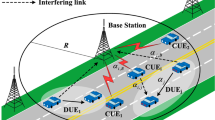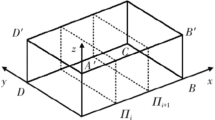Abstract
A dedicated single short range communication link is not efficient for an inter-vehicular communication system and results into degraded performance. To address the problem, a cognitive radio site is proposed as an intelligent vehicular device to implement an inter-vehicular communication network using multiple radio access technologies. Further, the whitespace optimization at vehicular speed is achieved by the memory enabled genetic algorithm. The algorithm makes use of four cognitive radio decision variables as genes including frequency, power, data rate and modulation scheme in the chromosome structure. The performance of the proposed approach is validated against the classical genetic algorithm and particle swarm optimization algorithm. In this research, a statistical evaluation is also presented to confirm the potential of cognitive radio paradigm employing multiple radio access technologies as an option to fulfill the increasing bandwidth demand of an inter-vehicular communication system. Experimental results demonstrate the effectiveness of the approach by ensuring efficient bandwidth utilization and fulfilling varying nature of users’ quality of service requirements in real time.






Similar content being viewed by others
References
Toroyan, T., & Peden, M. (Eds.). (2007). Youth and road safety. Geneva: World Health Organization.
Patton, G. C., Coffey, C., Sawyer, S. M., Viner, R. M., Haller, D. M., Bose, K., et al. (2009). Global patterns of mortality in young people: A systematic analysis of population health data. The Lancet, 374(9693), 881–892.
Fink, D. A. (2014). The Prevention of road accidents in the countries of Europe, Asia and the United States of America. World Applied Sciences Journal, 30(12), 1863–1869.
Traffic accidents—Pakistan Bureau of Statistics. http://www.pbs.gov.pk/sites/default/files/social_statistics/crime_statistics/traffic_accidents.pdf. Accessed on 9 September 2015.
Foss, R. D., & Goodwin, A. H. (2014). Distracted driver behaviors and distracting conditions among adolescent drivers: Findings from a naturalistic driving study. Journal of Adolescent Health, 54(5), S50–S60.
Rumschlag, G., Palumbo, T., Martin, A., Head, D., George, R., & Commissaris, R. L. (2015). The effects of texting on driving performance in a driving simulator: The influence of driver age. Accident Analysis and Prevention, 74(2015), 145–149.
Chan, M., & Singhal, A. (2013). The emotional side of cognitive distraction: Implications for road safety. Accident Analysis and Prevention, 50, 147–154.
Lansdown, T. C., Stephens, A. N., & Walker, G. H. (2015). Multiple driver distractions: A systemic transport problem. Accident Analysis and Prevention, 74, 360–367.
Kumar, K., Prem, S., Evangelin, J., Amudharani, V. A, Inbavalli, P., Suganya, R., & Prabu, U. (2015). Survey on collision avoidance in VANET. In Proceedings of the 2015 international conference on advanced research in computer science engineering & technology (ICARCSET 2015) (p. 46).
Reddy, Y. B. (2015). Security and design challenges in cyber-physical systems. In Information technology-new generations (ITNG), 2015 12th IEEE international conference (pp 200–205).
Rawat, D. B., Bajracharya, C., & Yan, G. (2015). Towards intelligent transportation Cyber-Physical Systems: Real-time computing and communications perspectives. SoutheastCon, 2015, 1–6.
Riaz, F., Shah, S. I., Raees, M., Shafi, I., & Iqbal, A. (2013). Lateral Pre-crash sensing and avoidance in emotion enabled cognitive agent based vehicle-2-vehicle communication system. International Journal of Communication Networks and Information Security (IJCNIS), 5(2), 127–140.
Tae, OH., Choi, Y. B., Guthrie, M., Harold, K., Copeland, D., & Kim, T. H. (2010). Reeling in cognitive radio: The issues of regulations and policies affecting spectrum management. International Journal of Future Generation Communication and Networking, 3(3), 71–79.
Chávez-Santiago, R., Szydełko, M., Kliks, A., Foukalas, F., Haddad, Y., Nolan, K. E., Kelly, M. Y., Masonta, M. T., & Balasingham, I. (2015). 5G: The convergence of wireless communications. Wireless Personal Communications 83(3), 1617–1642.
Mishra, S.M., Sahai, A., & Brodersen, R.W. (2006). Cooperative sensing among cognitive radios, communications. In ICC ‘06. IEEE international conference, vol. 4 (pp. 1658–1663).
Mitola III, J. (1999). Cognitive radio for flexible mobile multimedia communications. In IEEE International workshop on mobile multimedia communications (MoMuC'99) (pp. 3–10). San Diego, November 15–17 1999.
Deb, K. (2001). Multi-objective optimization using evolutionary algorithms (Vol. 16). New York: Wiley.
Hauris, J.F. (2007). Genetic algorithm optimization in a cognitive radio for autonomous vehicle communications. In Proceeding of the 2007 IEEE international symposium on computational intelligence in robotics and automation, Jacksonville, FL, USA, June 20–23 2007.
Singh, S. K., Singh, G., Pathak, V., Roy, D., & Chandra, K. (2011). Spectrum management for cognitive radio based on genetics algorithm. arXiv preprint arXiv:1101.4445.
Siddique, T. (2010). Spectrum optimization in cognitive radio networks using genetic algorithms. M.S Eletrical Engeneering. Thesis, Blekinge Institute of Technology, Sweden.
Chen, S., & Wyglinski, A. M. (2009). Cognitive radio-enabled distributed cross-layer optimization via genetic algorithms. In Cognitive radio oriented wireless networks and communications, 2009. CROWNCOM’09. 4th international conference (pp. 1–6).
Garvey, J. (2008) Car crash warning system could prevent the accident waiting to happen. http://www.gizmag.com/car-crash-warning-systemcould-prevent-the-accident-waiting-to-happen/8610. Accessed on 9 September 2015.
Jiang, D., & Delgrossi, L.(2008). IEEE 802.11p: Towards an international standard for wireless access in vehicular environments. In IEEE vehicular technology conference, 2008. VTC spring 2008, 11–14 May 2008.
IEEE Std 802.11p/D7.0. (2009). Wireless LAN medium access control (MAC) and physical layer (PHY) specifications: Wireless access in vehicular environment.
IEEE Std 1609.4-2006. (2006). IEEE trial-use standard for wireless access in vehicular environments (WAVE)—Multi-channel operation.
Wang, Z., & Hassan, M. (2008). How much of DSRC is available for non-safety use? In Proceedings of ACM VANET, San Francisco (pp. 23–29).
Noraini, M. R., & Geraghty, J. (2011). Genetic algorithm performance with different selection strategies in solving TSP. In Proceedings of the world congress on engineering 2011 Vol II WCE 2011, July 6–8, 2011, London, U.K.
Ghandour, A.J., Fawaz, K., & Artail, H. (2011). Data delivery guarantees in congested Vehicular ad hoc networks using cognitive networks. In Proceedings of 2011 7th international wireless communications and mobile computing conference (IWCMC), 4–8 July 2011 (pp. 871–876).
Ferreira, J., Fonseca, J., & Alves, J.A. (2012). Wireless vehicular communications for automatic incident detection and recovery. In Proceedings of portuguese conference on automatic control—CONTROLO, Funchal, Portugal (pp. 339–344).
Hassanzadeh, H. (2008) Reliable broadcast of safety messages in vehicular Ad hoc networks. Master thesis, Department of Electrical and Computer Engineering, University of Toronto.
Fawaz, K., Ghandour, A., Olleik, M., & Artail, H. (2010) Improving reliability of safety applications in vehicle Ad hoc networks through the implementation of a cognitive network. In IEEE ICT, Doha, Qatar.
Eichler, S. (2007). Performance evaluation of the IEEE 802.11p WAVE communication standard. In IEEE 66th vehicular technology conference, September 30–October 3 2007 (pp. 2199–2203).
Tsertou, A., & Laurenson, D. I. (2008). Revisiting the hidden terminal problem in a CSMA/CA wireless network. IEEE Transactions on Mobile Computing, 7(7), 817–831.
Bilstrup, K., Uhlemann, E., Strom, E. G., & Bilstrup, U. (2008). Evaluation of the IEEE 802.11p MAC method for vehicle-to-vehicle communication. IEEE VTC Fall, 2008(21–24), 1–5.
Wang, S. Y., Chao, H. L., Liu, K. C., He, T. W., Lin, C. C., & Chou, C. L. (2008). Evaluating and improving the TCP/UDP performances of IEEE 802.11(p)/1609 networks. In Proceedings of IEEE Symposium on Computers and Communications, (pp. 163–168).
Di Felice, M., Chowdhury, K.R., & Bononi, L. (2010). Analyzing the potential of cooperative cognitive radio technology on inter-vehicle communication. In Proceedings of the international conference on wireless days 2010 IFIP, 20–22 October 2010 (pp. 1–6).
Lan, K. C., & Li, M. W. (2010) Feasibility study of using FM radio for data transmission in a vehicular network. In Computer symposium (ICS), 2010 international, 16–18 December 2010 (pp. 55–60).
Fawaz, K., Ghandour, A., Olleik, M., & Artail, H. (2010). Improving reliability of safety applications in vehicle ad hoc networks through the implementation of a cognitive network. In IEEE 17th international conference on telecommunications (ICT), 4–7 April 2010 (pp. 798–805).
Li, H., & Irick, D.K. (2010). Collaborative spectrum sensing in cognitive radio vehicular Ad Hoc networks: Belief propagation on highway. In Vehicular technology conference (VTC 2010-spring), 2010 IEEE 71st, 16–19 May 2010 (pp. 1–5).
Wang, X. Y., & Ho, P. H. (2010). A novel sensing coordination framework for CR-VANETs. In IEEE transactions on vehicular technology, vol. 59, no. 4 (pp. 1936–1948).
Shagdar, O., Ohyama, T., Shirazi, M. N., Tang, S., Suzuki, R., Miura, R., Obana, S. (2009). Message dissemination in inter-vehicle CDMA networks for safety driving support. In Vehicular technology conference, 2009. VTC spring 2009. IEEE 69th, 26–29 April 2009 (pp. 1–5).
Ko, Y. F., Sim, M. L., & Nekovee, M. (2006). Wi-Fi based broadband wireless accessfor users on the road. BT Technology Journal Archive, 24(2), 123–129.
Mangel, T. (2012). Inter-vehicle communication at intersections: An evaluation of Ad-Hoc and cellular communication. PhD diseratation, KIT Scientific Publishing, 5 July 2012.
Buddhikot, M. M. (2010). Cognitive radio, DSA and Self-X: Towards next transformation in cellular networks. In Proceedings of IEEE symposium. New frontiers in dynamic spectrum (DySPAN’10).
Sachs, J., Marić, I., & Goldsmith, A. (2010) Cognitive cellular systems within the TV spectrum. In IEEE symposium on new frontiers in dynamic spectrum, IEEE 2010, (pp. 1–12).
Cabric, D., Mishra, S. M., & Brodersen, R. W. (2004). Implementation issues in spectrum sensing for cognitive radios. In Proceedings of Asilomar conference on signals, systems and computers (ACSSC), Pacific Grove, California, USA (pp. 772–776).
Ganesan, G., & Li, Y. (2005). Agility improvement through cooperative diversity in cognitive radio. In Global telecommunications conference, 2005. GLOBECOM ‘05.IEEE, vol. 5, 2–2 December 2005 (p. 5).
Bhargavi, D., & Murthy, C. R. (2010). Performance comparison of energy, matched-filter and cyclostationarity-based spectrum sensing. In IEEE eleventh international workshop on signal processing advances in wireless communications (SPAWC), 20–23 June 2010 (pp. 1–5).
Yuan, Y., Bahl, P., Chandra, R., Chou, P. A., Ferrell, J. I., Moscibroda, T., Narlanka, S., & Wu, Y. (2007) KNOWS: Cognitive radio networks over white spaces. In Proceedings of IEEE international symposium on new frontiers in dynamic spectrum access networks, Dublin, Ireland (pp. 416–427).
Yang, Y., Jiang, H., Liu, C., & Lan, Z. (2012). Research on cognitive radio engine based on genetic algorithm and radial basis function neural network, In 2012 Spring congress on proceedings of engineering and technology (S-CET), 27–30 May 2012 (pp. 1–5).
Wen, K., Fu, L., & Li, X. (2012). Genetic algorithm based spectrum allocation for cognitive radio networks. Advances in Computer, Communication, Control and Automation Lecture Notes in Electrical Engineering, 121, 693–700.
Xu, G., Tan, X., Ma, L., & Anghuwo, A. A. (2009). A construction algorithm of cognitive radio network with multiobjective genetic algorithm. In Proceedings of IEEE youth conference on information, computing and telecommunication, 2009. YC-ICT ‘09, 20–21 September 2009 (pp. 122–125).
Tang, P., & Lee, G. K. (2006). An adaptive fitness function for evolutionary algorithms using heuristics and prediction. In Proceedings of automation congress, 2006. WAC ‘06. world (pp. 1–6).
Chuang, Y. C., & Chen, C. T. (2011). A study on real-coded genetic algorithm for process optimization using ranking selection, direction-based crossover and dynamic mutation. In Proceedings of 2011 IEEE congress on evolutionary computation (CEC), 5–8 June 2011 (pp. 2488–2495).
Noraini, M. R., & Geraghty, J. (2011) Genetic algorithm performance with different selection strategies in solving TSP. In Proceedings of the world congress on engineering 2011 VolII WCE 2011, July 6–8, 2011, London, U.K.
Eberchart, R., & Kennedy, J. (1995). Particle swarm optimization. In Proceedings of IEEE international conference neural networks, Perth, Australia (pp. 1942–1948).
Waheed, M., & Cai, A. (2009). Evolutionary algorithms for radio resource management in cognitive radio network. In Proceedings of. 28th IEEE international conference on performance computing and communcations, 2009, Arizona, USA.
Mahdi, A. H., Mohanan, J., Kalil, M., & Mitschele-Thiel, A. (2012). Adaptive discrete particle swarm optimization for cognitive radios. ICC, 6550–6554.
Wang, Y., Zhang, Q., Zhang, Y., & Chen, P. (2011). Adaptive resource allocation for cognitive radio networks with multiple primary networks. EURASIP Journal on Wireless Communications and Networking,. doi:10.1186/1687-1499-2012-252.
Juang, C. F. (2004). A hybrid of genetic algorithm and particle swarm optimization for recurrent network design. In IEEE transactions on systems, man, and cybernetics—Part B: Cybernetics, vol. 34, no. 2.
Author information
Authors and Affiliations
Corresponding author
Rights and permissions
About this article
Cite this article
Riaz, F., Shafi, I., Jabbar, S. et al. A Novel White Space Optimization Scheme Using Memory Enabled Genetic Algorithm in Cognitive Vehicular Communication. Wireless Pers Commun 93, 287–309 (2017). https://doi.org/10.1007/s11277-015-3117-4
Published:
Issue Date:
DOI: https://doi.org/10.1007/s11277-015-3117-4




